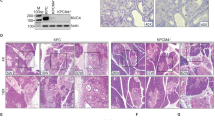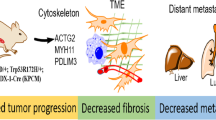Abstract
MUC4 encodes a large transmembrane mucin that is overexpressed in pancreatic adenocarcinomas. The molecular mechanisms responsible for that altered pattern of expression are unknown. TGF-β, a pleiotropic cytokine, regulates numerous genes involved in pancreatic carcinogenesis via activation of the Smads proteins and MUC4 promoter is rich in Smad-binding elements. Our aim was to study whether the regulation of MUC4 expression by TGF-β in pancreatic cancer cells was strictly dependent on Smad4 activity. Three pancreatic cancer cell lines, CAPAN-1 (MUC4+/Smad4−), CAPAN-2 (MUC4+/Smad4+) and PANC-1 (MUC4−/Smad4+), were used. By RT–PCR, transfection assays and immunohistochemistry, we show that (i) both MUC4 mRNA and apomucin expression are upregulated by TGF-β, (ii) Smad2 positively cooperates with Smad4 to activate the promoter, (iii) activation of Smad4 by exogenous TGF-β induces Smad4 binding to the promoter, (iv) Smad7 and c-ski both inhibit activation by Smad4. When Smad4 is mutated and inactive, TGF-β activates MUC4 expression via MAPK, PI3K and PKA signaling pathways. Absence of expression in PANC-1 cells is due to histone deacetylation. Altogether, these results indicate that upregulation of MUC4 by TGF-β is restricted to well-differentiated pancreatic cancer cells, and point out a novel mechanism for TGF-β as a key molecule in targeting MUC4 overexpression in pancreatic adenocarcinomas.
This is a preview of subscription content, access via your institution
Access options
Subscribe to this journal
Receive 50 print issues and online access
$259.00 per year
only $5.18 per issue
Buy this article
- Purchase on Springer Link
- Instant access to full article PDF
Prices may be subject to local taxes which are calculated during checkout







Similar content being viewed by others
References
Akhurst RJ and Derynck R . (2001). Trends Cell Biol., 11, S44–S51.
Audié JP, Janin A, Porchet N, Copin MC, Gosselin B and Aubert JP . (1993). J. Histochem. Cytochem., 41, 1479–1485.
Balagué C, Audié JP, Porchet N and Real FX . (1995). Gastroenterology, 109, 953–964.
Baldwin RL, Friess H, Yokoyama M, Lopez ME, Kobrin MS, Büchler MW and Korc M . (1996). Int. J. Cancer, 67, 283–288.
Carraway KL, Price-Schiavi SA, Komatsu M, Idris N, Perez A, Li P, Jepson S, Zhu X, Carjaval ME and Carothers Caraway CA . (2000). Front. Biosci., 5, 95–107.
Choudhury A, Moniaux N, Winpennynn JP, Hollingsworth MA, Aubert JP and Batra SK . (2000a). J. Biochem., 128, 233–243.
Choudhury A, Singh RK, Moniaux N, El-Metwally TH, Aubert JP and Batra SK . (2000b). J. Biol. Chem., 275, 33929–33936.
De Caestecker MP, Piek E and Roberts AB . (2000). J. Natl. Cancer Inst., 92, 1388–1402.
Derynck R, Akhurst RJ and Balmain A . (2001). Nat. Genet., 29, 117–129.
Gendler S . (2001). J. Mamm. Gland Biol. Neopl., 6, 339–353.
Hollingsworth MA, Strawhecker JM, Caffrey TC and Mack DR . (1994). Int. J. Cancer, 57, 198–203.
Hollingsworth MA and Swanson BJ . (2004). Nat. Rev., 4, 45–60.
Hruban RH . (2001). J. Gastroenterol. Surg., 5, 583–587.
Huguier M and Mason NP . (1999). Am. J. Surg., 177, 257–265.
Kim YS, Gum Jr JR, Crawley SC and Ho JJL . (1999). Ann. Oncol., 10, S51–S55.
Lichtenstein DR and Carr-Locke DL . (1995). Gastrointest. Endosc. Clin. N. Am., 5, 237–258.
Mariette C, Perrais M, Leteurtre E, Jonckheere N, Hémon B, Pigny P, Batra SK, Aubert JP, Triboulet JP and Van Seuningen I . (2004). Biochem. J., 377, 701–708.
Massagué J and Wotton D . (2000). EMBO J., 19, 1745–1754.
Mesquita P, Jonckheere N, Almeida R, Ducourouble MP, Serpa J, Pigny P, Santos silva F, Reis C, Silberg D, Van Seuningen I and David L . (2003). J. Biol. Chem., 278, 51549–51556.
Miyaki M and Kuroki T . (2003). Biochem. Biophys. Res. Commun., 306, 799–804.
Miyazono K, Suzuki H and Imamura T . (2003). Cancer Sci., 94, 230–234.
Moniaux N, Escande F, Porchet N, Aubert JP and Batra SK . (2001). Front. Biosci., 6, d1192–d1206.
Park HU, Kim JW, Kim GE, Bae HI, Crawley SC, Yang SC, Gum J, Batra SK, Rousseau K, Swallow DM, Sleisenger MH and Kim YS . (2003). Pancreas, 26, E48–E54.
Perrais M, Pigny P, Copin MC, Aubert JP and Van Seuningen I . (2002). J. Biol. Chem., 277, 32258–32267.
Perrais M, Pigny P, Ducourouble MP, Petitprez D, Porchet N, Aubert JP and Van Seuningen I . (2001). J. Biol. Chem., 276, 30923–30933.
Quandt K, Frech K, Karas H, Wingender E and Werner T . (1995). Nucleic Acids Res., 23, 4878–4884.
Roberts AB . (2002). Cytokine Growth Fact. Rev., 13, 3–5.
Sakorafas GH, Tsiotou AG and Tsiotos GG . (2000). Cancer Treat. Rev., 26, 29–52.
Schutte M . (1999). Ann. Oncol., 10, S56–S59.
Schutte M, Hruban RH, Hedrick L, Cho KR, Nadasky GM, Weinstein CL, Bova GS, Isaacs WB, Cairns P, Nawroz H, Sidransky D, Casero RA, Meltzer PS, Hahn SA and Kern SE . (1996). Cancer Res., 56, 2527–2530.
Singh AP, Moniaux N, Chauhan SC, Meza JL and Batra SK . (2004). Cancer Res., 64, 622–630.
Sipos B, Möser S, Kalthoff H, Török V, Löhr M and Klöppel G . (2003). Virchows Arch., 442, 444–452.
Soto P, Price-Schiavi SA and Carraway KL . (2003). J. Biol. Chem., 278, 20338–20344.
Swartz MJ, Batra SK, Varshney GC, Hollingsworth MA, Yeo CJ, Cameron JL, Wilentz RE, Hruban RH. and Argani P . (2002). Am. J. Clin. Pathol., 117, 791–796.
Ten Dijke P, Miyazono K and Heldin CH . (2000). Trends Biochem. Sci., 25, 64–70.
Van Seuningen I, Ostrowski J, Bustelo XR, Sleath P and Bomsztyk K . (1995). J. Biol. Chem., 270, 26976–26985.
Van Seuningen I, Perrais M, Pigny P, Porchet N and Aubert JP . (2000). Biochem. J., 348, 675–686.
Wilentz RE, Iacobuzio-Donahue CA, Argani P, McCarthy DM, Parsons JL, Yeo CJ, Kern SE and Hruban RH . (2000). Cancer Res., 60, 2002–2006.
Acknowledgements
We are indebted to Marie-Paule Ducourouble, Brigitte Hémon and Audrey Vincent for their excellent technical help. We would like to thank Dr Azzedine Atfi (Unité INSERM N°482, Paris) for the kind gifts of pCMV-Smad2, pcDNA3/Myc-Smad3, pcDNA3/HA-Smad4, pcDNA3-Smad7 expression vectors and Dr Myasoko (University of Tokyo, Japan) for the gift of pcDNA3-c-Ski expression vector. This work was supported by grants from l'Association de Recherche contre le Cancer (IVS, No 5785), from la Ligue Régionale du Pas de Calais contre le Cancer (IVS) and by an RO1 grant CA78590 from the National Institutes of Health (SKB). N Jonckheere is the recipient of a CHRU de Lille-Région Nord-Pas de Calais PhD fellowship.
Author information
Authors and Affiliations
Corresponding author
Rights and permissions
About this article
Cite this article
Jonckheere, N., Perrais, M., Mariette, C. et al. A role for human MUC4 mucin gene, the ErbB2 ligand, as a target of TGF-β in pancreatic carcinogenesis. Oncogene 23, 5729–5738 (2004). https://doi.org/10.1038/sj.onc.1207769
Received:
Revised:
Accepted:
Published:
Issue Date:
DOI: https://doi.org/10.1038/sj.onc.1207769
Keywords
This article is cited by
-
Mucin glycoproteins block apoptosis; promote invasion, proliferation, and migration; and cause chemoresistance through diverse pathways in epithelial cancers
Cancer and Metastasis Reviews (2019)
-
Integrative analysis of the cancer genome atlas and cancer cell lines encyclopedia large-scale genomic databases: MUC4/MUC16/MUC20 signature is associated with poor survival in human carcinomas
Journal of Translational Medicine (2018)
-
miR-219-1-3p is a negative regulator of the mucin MUC4 expression and is a tumor suppressor in pancreatic cancer
Oncogene (2015)
-
Specific-detection of clinical samples, systematic functional investigations, and transcriptome analysis reveals that splice variant MUC4/Y contributes to the malignant progression of pancreatic cancer by triggering malignancy-related positive feedback loops signaling
Journal of Translational Medicine (2014)
-
Oncogenic PAK4 regulates Smad2/3 axis involving gastric tumorigenesis
Oncogene (2014)



